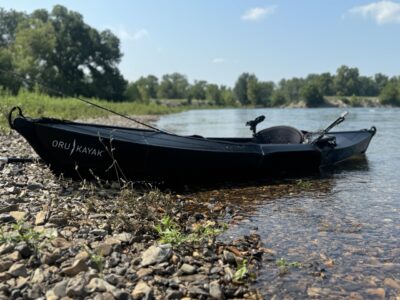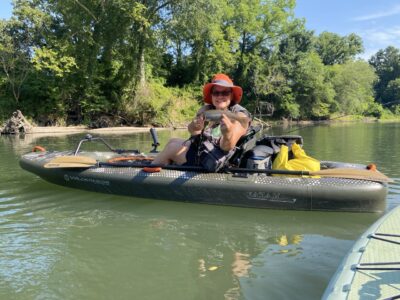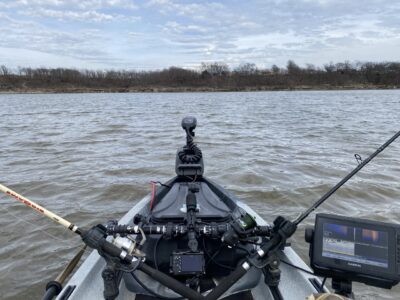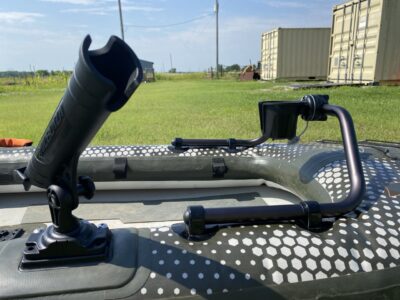OutdoorHub
Rigging a Fishing Kayak: From Plain Jane to Decked Out
Rigging a fishing kayak properly will make your adventures exponentially more enjoyable. I’m often asked why my kayak is decked out with so much gear, and my answer remains that I enjoy it. However, I understand some anglers enjoy a much more simplistic approach, so I’ve covered the spectrum in this article.
By the end, you’ll better understand how to rig your kayak from plain Jane to fully loaded and everything in between. So that you have the best possible time on the water.
Plain Jane Approach

Even though I’m a bit of a gear junkie, I love the minimalistic approach. The great thing about kayak fishing is that you only need a kayak, a paddle, a PFD, a fishing rod, and a few lures to start catching fish.
This is my favorite way to rig a kayak when fishing a river or when I’m limited on time. I keep my rod lying across the deck or in my lap while I paddle, and my small tackle box under or behind my seat. There’s no need to run wires or figure out how to install anything, making this approach appealing to beginners.
Traditionalists swear that this is the only way to kayak fish, because they believe that adding extra gear detracts from the spirit of kayak fishing. While I understand where they’re coming from, I would disagree that it’s the only way. I believe a balance can be struck between minimalism and overkill.
Goldilocks Approach

The Goldilocks approach is that perfect middle ground most kayak anglers will find themselves in. Generally, rigging a fishing kayak this way involves adopting a minimalist mentality, incorporating electronics, utilizing a different method of propulsion, and carrying additional gear.
It’s also when learning how to rig a fishing kayak properly is incredibly beneficial. This is where I started as a new kayak angler because I already had a lot of fishing gear, so I had to learn how to manage it in a small space.
Here’s how I set up my kayak for most trips:
I prefer to keep the deck as open as possible, whether paddling, pedaling, or using a trolling motor. This allows me to land fish more easily and stay comfortable, stretching my legs and standing up.
When using my bow mount trolling motor, I have a plug in the front of the kayak, with wires running to a plug in the back, where my battery sits. I also keep my kayak crate (loaded with all my lures, rods, and net) just behind my seat for quick access.
If I’m catfishing or trolling, I’ll have a couple of rod holders mounted to the tracks on either side of the kayak.
My biggest mistake when learning how to rig a fishing kayak was not testing the rigging I had done. I would make an adjustment permanent by drilling or screwing into the kayak before I tested to see how I liked it. Inevitably, I wanted to adjust it, but I didn’t want to drill more holes. That’s why I recommend using the gear tracks as much as possible. You can quickly adjust your rod holders, electronics, and any other gear installed on them without the need for additional drilling.
The Goldilocks approach is all about testing and tinkering with what works best for you, but sometimes you’ve just gotta go big or go home.
Decked Out Approach

We’ve finally come to my favorite part of the article because it speaks to the gear junkie in me. However, this approach is overkill for 99% of anglers. Kayak tournament anglers and guides are the only ones who need to rig a kayak like this, but as a weekend warrior, it’s fun to have at your disposal.
A decked out kayak typically has one or two motors (a trolling motor on the front and an electric 2-3hp motor on the back), electronics (2 screens, one of which is dedicated to live sonar), a shallow water anchor, 6-8 rods and rod holders, and a kayak crate jam packed with tackle boxes.
You must master how to rig a fishing kayak to have an enjoyable time on the water; otherwise, you’ll fight your gear the entire trip. Trust me, it’s not fun.
My typical decked-out setup is a bow-mounted trolling motor, fish finder, 6-8 rods, paddle, net, fully loaded kayak crate, and a shallow water anchor. I still want my deck uncluttered as much as possible, so I keep the crate and rod holders behind my seat. I can’t do that with the fish finder, but I have it mounted on gear tracks, so it’s out of the way but accessible.
My biggest recommendation when taking this approach is to do it in stages. I’m glad that I learned how I liked my fish finder set up before I installed my trolling motor.
Lastly, I’m still improving my setup. Just this weekend, I rigged up a couple of pull cords to make deploying and retracting my trolling motor much easier. It’s something I wish I had done sooner.
Parting Shots: Rigging a Fishing Kayak

I constantly adjust my rig to match my trip, as I fish in various locations, including lakes, rivers, creeks, and ponds. So, on some trips, I need all my electronics; on others, I need the bare essentials. Rigging a fishing kayak is a personal endeavor, so my perfect setup probably won’t work for you, but you can get ideas from other anglers to improve your rig.
Rigging a fishing kayak is a never-ending process, so enjoy the experience.
The post Rigging a Fishing Kayak: From Plain Jane to Decked Out appeared first on OutdoorHub.


